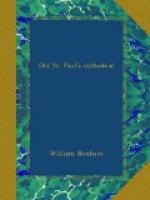The Archdeacons of London, Middlesex, and Colchester had their own stalls in the cathedral, but had no voice in the Chapter.
The Minor Canons, twelve in number, formed a separate college, founded in the time of Richard II. They were, of course, under the authority of the cathedral, though they had independent estates of their own.
The Scriptorium of St. Paul’s was an important department, and was well managed. Much of the work produced in it perished in the fire; but there are some of its manuscripts still happily preserved, notably the Majora Statuta of the cathedral, in the Library there, and a magnificent folio of Diceto’s History, now in Lambeth Library.
Incidental notice has been taken in the preceding pages of Chantries in St. Paul’s, but we have to speak more fully of these, for they formed a very large source of income, especially to the Residentiary Canons. These Chantries were founded for saying masses for the souls of the departed, even to the end of the world. St. Paul’s was almost beyond measure rich in them. The oldest was founded in the reign of Henry II., after which time they multiplied so fast that it would be impossible to enumerate them all here. There is a return of them (quoted at length by Dugdale), which was made by order of King Edward VI. Take the description of the second of them as he gives it. “The next was ordained by Richard, surnamed Nigell [Fitzneal], Bishop of London in King Richard I.’s time, who having built two altars in this cathedral, the one dedicated to St. Thomas the Martyr, and the other to St. Dionis, assigned eight marks yearly rent, to be received out of the church of Cestreheart, for the maintaining of two priests celebrating every day thereat; viz., one for the good estate of the King of England and Bishop of London for the time being; as also for all the congregation of this church, and the faithful parishioners belonging thereto, and the other for the souls of the Kings of England and Bishops of London, and all the faithful deceased: which grant was confirmed by the Chapter.” This is a fair specimen; they go on page after page in Dugdale’s folio. William de Sanctae Mariae ecclesia (he was Dean 1241-1243) leaves 120 marks for bread and beer yearly to a priest who shall celebrate for his soul and for the souls of his predecessors, successors, parents, and benefactors. Sometimes special altars are named at which the Mass is to be said, “St. Chad, St. Nicholas, St. Ethelbert the King, St. Radegund, St. James, the twelve Apostles, St. John the Evangelist, St. John Baptist, St. Erkenwald, St. Sylvester, St. Michael, St. Katharine.” I take them as they come in the successive testaments. The following passage is worth quoting:—“In 19 Ed. II. Roger de Waltham, a Canon of this church, enfeoft the Dean and Chapter of certain messuages and shops lying within the city of London, for the support of two priests to pray perpetually for his soul, and




